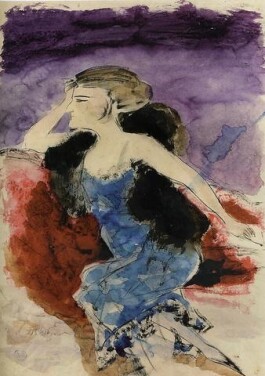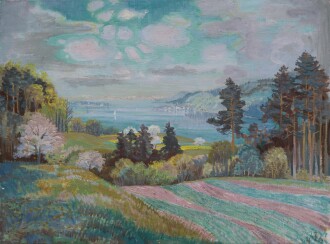Works by Otto Dix at Sotheby's
Otto Dix Biography
Known for his unforgiving and often critical depictions of German society during the Weimar Republic, as well as his unflinching portrayals of war, Otto Dix has come to be recognized as one of the most important and pivotal artists of the Neue Sachlichkeit (or “New Objectivity”) movement. Dix was born in 1891 in Untermhaus, Germany, and received sporadic artistic training as a child. In 1910, however, following a move to Dresden, he enrolled at the Grand Ducal Saxon School of Arts and Crafts.
During his artistic studies, he showed a pronounced interest in theology, philosophy, and more specifically the writings of Nietzsche and Goethe. Though the school did not teach Academic painting, he closely studied the work of historical Dutch and German artists, as well as the Italian Old Masters, and through his observations taught himself learned these artists’ techniques. Dix was experimental in his practice, expanding his repertoire by branching out from painting to complete pen and ink drawings as well as prints on paper. His artistic pursuits, however, were interrupted by the outbreak of World War I. Having volunteered for service, he eventually worked as a machine gunner on the frontlines in France, and was wounded (once nearly fatally) several times. The horrors of war deeply affected the artist, and many of his troubling experiences were recorded through the several hundred sketches and gouaches he completed while in the service. Following the conclusion of the War, he continued his studies in art at the Kunstakademie in Dresden from 1919 until 1922.
Although Dresden suffered greatly during the aftermath of the international conflict, it soon became a locus for the artistic, political and philosophical avant-garde. Within this context, Dix was free to further experiment with his art-making, drawing inspiration from Futurism and Cubism, among other wide-ranging stylistic modes. By 1919, he and a group of like-minded artists founded the Dresden Secession Group, eventually leading him to be exposed to, and to utilize, methods and motifs of both Dadaism and collage.
By 1925, Dix and his wife Martha Koch relocated to Berlin, where he would begin completing the portraits that have come to represent arts in Germany during the interwar period. The following year, he was made a professor at the Kunstakademie, and his career flourished until 1933 when the National Socialist party came to power and they ultimately stripped him of his position. No longer having a steady income, and with social and political tensions making it near impossible to support himself and his family, Dix and his family moved to Lake Constance where they resided in relative quiet throughout World War II. Dix, like so many of his contemporaries, was included in the Degenerate Art exhibition of 1937, despite having more or less relegated himself to painting subtler compositions such as landscapes by that point.
Following the Second World War, he returned a style similar to his pre-1923 mode, which was largely representational and figurative despite the shifting popularity towards abstraction. Dix died in 1969 following a stroke. Following a resurgence of interest and attention to the Neue Sachlichkeit, he was the subject of a catalogue raisonné project in 1960, and consideration of his contributions to German art, as well as Modernism on a whole, has continued to the present day; today, his work is included in the permanent collections of the Museum of Modern Art, New York; the National Gallery of Art, Washington, DC; the Städel Museum, Frankfurt; Kunstmuseum Basel; and the State Museums of Berlin.












